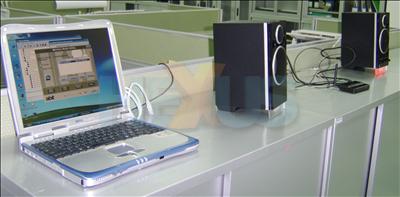AirPace, PCI-Express WiFi and more
Another interesting product was abit's AirPace wireless music player, here shown hooked up to a WiFi-enabled laptop installed with the requisite software.
The standalone unit boasts the usual connections seen on decent hi-fi, and, in this case, up to a pair of active abit iDome speakers. Going through S/PDIF, for example, will let you run 6-channel sound (speakers and audio permitting, of course). The AirPace, complete with remote control, as you would expect, allows you to stream your audio files from the main music-holding PC. The technology is licensed from Azure Audio and, to this hack's ears, the sound quality was more than adequate. If connected to your router, the AirPace can function as a wireless access point, too.
The software also includes a buffer option which stores audio should the wireless link be swamped with too much bandwidth at any one time. Initial pricing for the AirPace will see it retail for around 79 Euros, so that's £50 for us in the U.K.
Now for something completely different. How many of you have a fish tank on your desk? Going with the evidence of Taiwanese companies' R+D departments it's a common fad; just don't dip your mobile phone in there!
Here's another gratuitous R+D shot.
We spoke of high-end motherboard bundling earlier. Here's what abit plans to bundle in with its premium IN9 32-MAX. Looks like a regular WiFi card that you'd slot into your PC, right? It is, in the main, but take a closer look at the interface and geeks amongst you will notice that it's PCIe x1 that will also fit into x4, x8, and x16 mechanical slots. It's about time that companies started to release a greater range of PCIe-based peripherals and the fact that abit is bundling it in with its premium board is a good thing. It will also be available as a retail-boxed version with additional software for around £39, we were told.
What our brief visit to abit's HQ told us was that the company is proposing a distinct shift in philosophy, from a motherboard-only outfit to a multimedia business. We've seen this before with the aforementioned ASUSTek and MSI laterally diversifying into all manner of peripherals. Only time will tell whether distinct bundling and a new line of multimedia products will be well-received by the market.
Is abit back, as the abit of old? A new logo does not a new company make, but the signs are good. The time from chipset introduction to an abit motherboard hitting the retail shelves has been cut, hugely so, in 2006, which, in our opinion, is a precursor to abit's fortunes getting back on track. 2007 should be an interesting year with interesting products; we can't wait to see what other tricks it has up its sleeve.


















